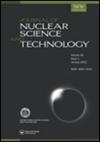74,76,78,80,82se的k -中子俘获截面和俘获伽马能谱测量
IF 1.7
4区 工程技术
Q2 NUCLEAR SCIENCE & TECHNOLOGY
引用次数: 0
摘要
摘要在15 ~ 100 keV和550 keV范围内测量了74,76,78,80,82se的中子俘获截面和俘获γ射线能谱。利用基于7Li(p,n)7Be反应的ns脉冲中子源和大型反康普顿NaI(Tl) γ射线谱仪,采用了中子飞行时间法。将脉冲高度加权技术应用于观测到的γ射线脉冲高度光谱,以获得捕获产率。采用197Au的标准俘获截面,得到了74,76,78,80se的俘获截面,其不确定度在4.0 ~ 5.5%之间,82Se的俘获截面的不确定度在6.5 ~ 27%之间。78,82se的实验结果是第一个在分辨共振区域以上的实验结果。将本研究结果与先前的测量结果以及JENDL-5.0和ENDF/B-VIII.0中的评估值进行比较。JENDL-5.0的评价结果与目前的74、76、78、80Se和82Se的结果分别相差0.9-51%和6.9-120%。通过展开观测到的捕获γ射线脉冲高度谱,得到了74,76,78,80,82se的捕获γ射线谱。这是keV区域的首次实验结果。关键词:中子捕获横截面伽马光谱范围硒74selenium 76selenium 78selenium 80selenium 82硒79gold抗康普顿NaI(Tl)伽马射线光谱仪飞行时间法脉冲高度加权技术免责声明作为对作者和研究人员的服务,我们提供此版本的接受稿件(AM)。在最终出版版本记录(VoR)之前,将对该手稿进行编辑、排版和审查。在制作和印前,可能会发现可能影响内容的错误,所有适用于期刊的法律免责声明也与这些版本有关。本研究由日本教育、文化、体育、科学和技术部资助(No. 19360423)。这项工作也得到了KAKENHI补助金-in- aids (21K04580)的出版支持。本研究得到了日本教育、文化、体育、科学和技术部的资助[19360423]。本文章由计算机程序翻译,如有差异,请以英文原文为准。
Measurements of keV-Neutron capture cross sections and capture gamma-ray spectra of 74 ,76 ,78 ,80 ,82Se
ABSTRACTThe neutron capture cross sections and capture γ-ray spectra of 74,76,78,80,82Se were measured in a region from 15 to 100 keV and around 550 keV. A neutron time-of-flight method was used with a ns-pulsed neutron source based on the 7Li(p,n)7Be reaction and a large anti-Compton NaI(Tl) γ-ray spectrometer. A pulse-height weighting technique was applied to the observed γ-ray pulse-height spectra to obtain capture yields. The capture cross sections of 74,76,78,80Se were derived with uncertainties from 4.0 to 5.5% and those of 82Se were derived with uncertainties of 6.5–27% by using the standard capture cross sections of 197Au. The present results of 78,82Se were the first experimental ones above the resolved resonance region. The present results were compared with previous measurements and the evaluated values in JENDL-5.0 and ENDF/B-VIII.0. The evaluations of JENDL-5.0 differ from the present results of 74,76,78,80Se and 82Se by 0.9–51% and 6.9–120%, respectively. The capture γ-ray spectra of 74,76,78,80,82Se were derived by unfolding the observed capture γ-ray pulse-height spectra. The present results were the first experimental ones in the keV region.KEYWORDS: Neutron capturecross sectionsgamma spectrakev rangeselenium 74selenium 76selenium 78selenium 80selenium 82selenium 79gold 197Anti-compton NaI(Tl) gamma-ray spectrometertime-of-flight methodpulse-height weighting techniqueDisclaimerAs a service to authors and researchers we are providing this version of an accepted manuscript (AM). Copyediting, typesetting, and review of the resulting proofs will be undertaken on this manuscript before final publication of the Version of Record (VoR). During production and pre-press, errors may be discovered which could affect the content, and all legal disclaimers that apply to the journal relate to these versions also. AcknowledgementThe present study was supported by a Grant-in-Aid (No. 19360423) of the Japan Ministry of Education, Culture, Sports, Science and Technology. This work was also supported by KAKENHI Grant-in-Aids (21K04580) for publication.Additional informationFundingThe work was supported by the a Grant-in-Aid of the Japan Ministry of Education, Culture, Sports, Science and Technology [19360423].
求助全文
通过发布文献求助,成功后即可免费获取论文全文。
去求助
来源期刊

Journal of Nuclear Science and Technology
工程技术-核科学技术
CiteScore
2.40
自引率
16.70%
发文量
116
审稿时长
2.3 months
期刊介绍:
The Journal of Nuclear Science and Technology (JNST) publishes internationally peer-reviewed papers that contribute to the exchange of research, ideas and developments in the field of nuclear science and technology, to contribute peaceful and sustainable development of the World.
JNST ’s broad scope covers a wide range of topics within its subject category, including but are not limited to:
General Issues related to Nuclear Power Utilization: Philosophy and Ethics, Justice and Policy, International Relation, Economical and Sociological Aspects, Environmental Aspects, Education, Documentation and Database, Nuclear Non-Proliferation, Safeguard
Radiation, Accelerator and Beam Technologies: Nuclear Physics, Nuclear Reaction for Engineering, Nuclear Data Measurement and Evaluation, Integral Verification/Validation and Benchmark on Nuclear Data, Radiation Behaviors and Shielding, Radiation Physics, Radiation Detection and Measurement, Accelerator and Beam Technology, Synchrotron Radiation, Medical Reactor and Accelerator, Neutron Source, Neutron Technology
Nuclear Reactor Physics: Reactor Physics Experiments, Reactor Neutronics Design and Evaluation, Reactor Analysis, Neutron Transport Calculation, Reactor Dynamics Experiment, Nuclear Criticality Safety, Fuel Burnup and Nuclear Transmutation,
Reactor Instrumentation and Control, Human-Machine System: Reactor Instrumentation and Control System, Human Factor, Control Room and Operator Interface Design, Remote Control, Robotics, Image Processing
Thermal Hydraulics: Thermal Hydraulic Experiment and Analysis, Thermal Hydraulic Design, Thermal Hydraulics of Single/Two/Multi Phase Flow, Interactive Phenomena with Fluid, Measurement Technology...etc.
 求助内容:
求助内容: 应助结果提醒方式:
应助结果提醒方式:


